Physical therapy has a range of advantages, as well as pre-surgery and post-surgery
rehabilitation, rising quality once injuries, and relieving pain. One in each
of the numerous conditions that physiotherapy will facilitate with is tennis
elbow – a typical injury that is additionally referred to as tendinitis.
Below is an aspect of what tennis elbow is and the way
physiotherapy for tennis elbow is helpful.
What is
tennis elbow?
Tennis elbow is that the common term for the pain that
happens once the tendons on the outer facet of your elbow are overworked
because of repeated use. It is also commonly called "lateral
epicondylitis" and it's principally caused by inflammation of the foreman
muscle that's it connected to the elbow.
Generally, tennis elbow is that the results of extremely repetitive movements like in tennis,
racketball, and even in jobs like painting and construction. One factor to
notice is that though the condition has ‘tennis’ in its name, the condition
doesn’t solely have an effect on athletes. Anyone concerned in any activity
that involves repeatedly moving your wrist and arm may well be tormented by
this condition.
What are
the causes and symptoms of the tennis elbow?
Surprisingly, if you’re using your joints and muscles
inefficaciously, even some everyday activities - like chopping up ingredients
for cookery, prolonged usage of a mouse, using tools, or maybe painting, will
cause a tennis elbow. Common symptoms embrace pain and weakness on the surface of your elbow, which may typically
radiate to your wrist and forearm.
How can
physical therapy help with tennis elbow?
Physical therapy is a large facility for tennis elbow – not
solely up to the motion of the joint, but also, in time, reducing and
eventually eliminating the pain of the injury. Your therapist can work with you
to spot why your injury might need to happen, and compute some exercises that
may assist you to use your joints more effectively, and take the strain off
them.
Exercises they could recommend square measure aimed toward
up blood flow to the tendons, which usually receive very less oxygen than
muscles around them, or may be targeted on many different things:
- Exercises that involve stretching and strengthening of the muscles;
- Massaging using essential oils or ice to cut back inflammation;
- Stimulating the muscles to boost blood flow;
- Using straps or braces to produce extra support till your elbow has well sufficiently.
What are
some physical therapy exercises for tennis elbow?
Your physiotherapist can build an idea that works
specifically for you, however here ar a number of exercises that they may
suggest:
Wrist extension –
take a lightweight dumbbell (two pounds or less) and hold it in your out of
action hand, palm facing down. Sit down and rest your hurt elbow on your knee,
along with your articulatio plana extended outward. Curl your wrist slightly
downward and do it again.
Wrist flexion –
This is often like a wrist extension, except that you simply curl the
articulatio plana of your out of action arm upward and back off to its original
position. Repeat the movement around 10 times, and stop once your arm feeling
weak.
Towel twists –
Sit down on a chair, and keep your shoulders relaxed. Hold a towel with each
hand, and twist it as you'd to wring water off a wet towel. Repeat this
movement 10 times in one direction, and 10 times within the different.
These may match for
you, however after all, like any injury, it’s an best plan to go to a therapist to get proper treatment, tailored for your injury, as a part of an entire set up.
If you want to contact physical therapy center that effectively heal your elbow
then Physical Therapy New York, NY is
right place.









